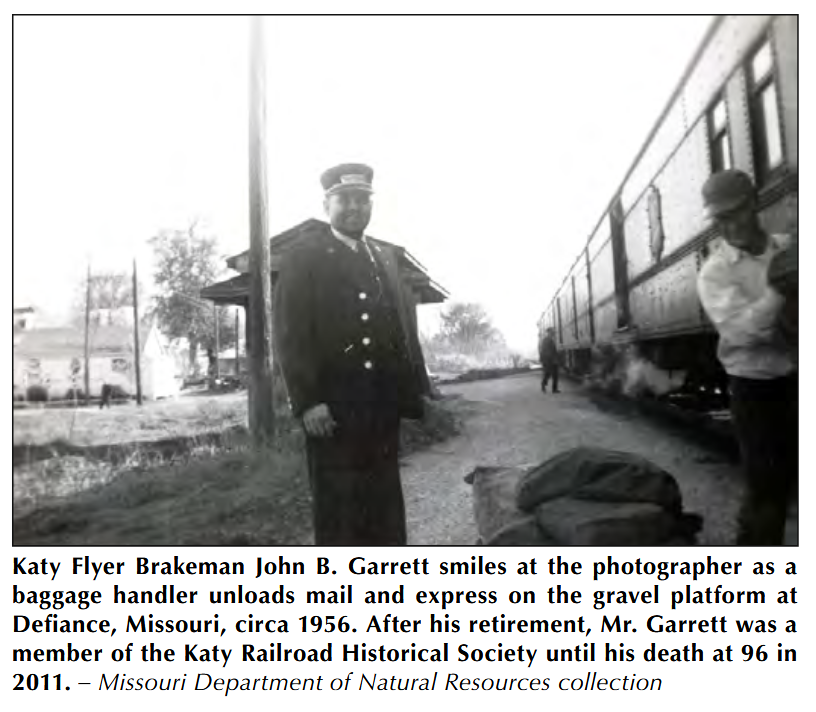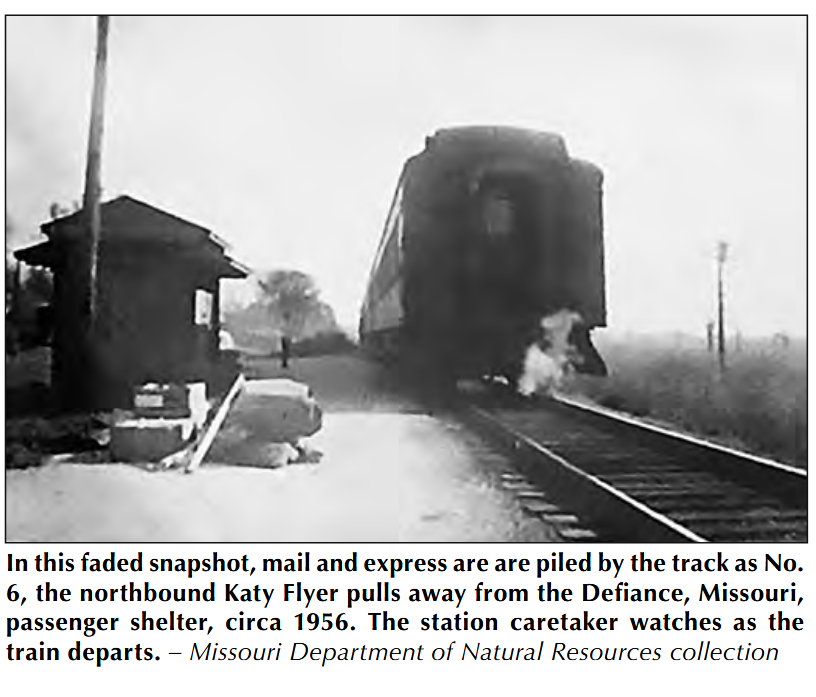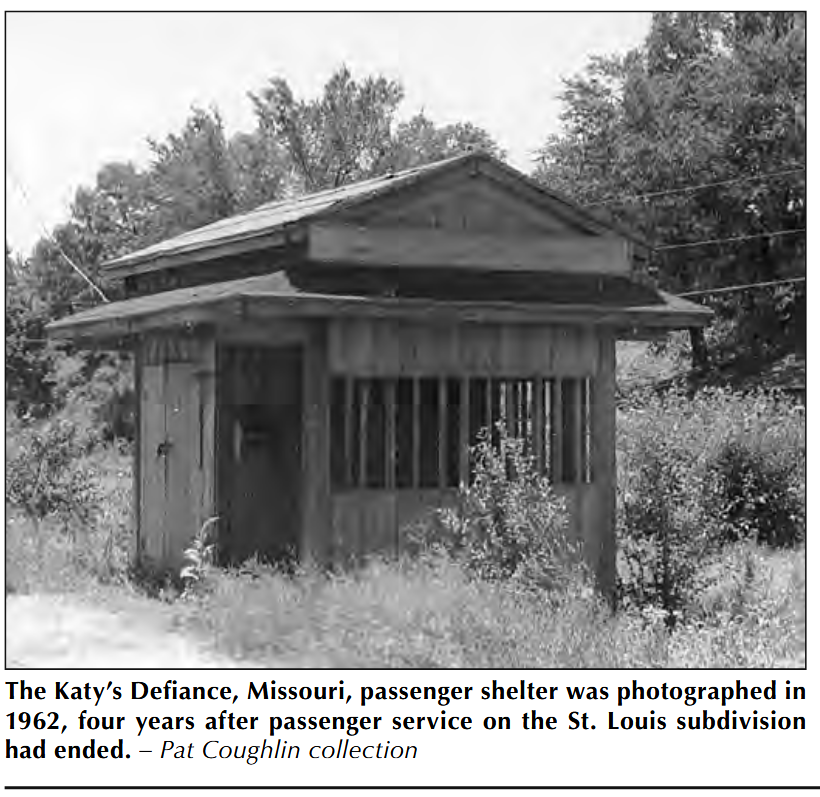TILIW – Raymond George, Defiance, and the Katy
- Friends of Historic Augusta
- Aug 25
- 9 min read
MK&T_Salem School_rude awakening_Pam Jensen_Magnificent MO_Marthasville depot_Katy Flyer_Katy Railroad Historical Society
Gentle readers, neither I, nor any of my relatives, ever worked for the MK&T rail system. What’s more, I was never even a passenger on what was affectionately known as the Katy. And yet I feel a certain affiliation with, and even affection for, that railway.
For 6 years, it ran through the front yard of my home, the old Salem School House (which was located below what is now the Augusta Shores dam). When I first inhabited the schoolhouse in 1980, I would often leap out of bed at night when the Katy roared past shaking my windows and walls; what a rude and disorienting awakening.

The Salem School after I raised it 2 feet.
Other times, the train would come to a complete halt along Highway 94 thereby blocking my driveway. If I happened to come home at such a time, I would…perhaps foolishly…crawl under the belly of the beast to get into my yard where my friendly goats would greet me.
I also have one very pleasant memory of finding a nice mess of morels on the bank below the tracks. A few minutes later the MKT flew past, and I waved my shrooms like a mad man while the train personnel gave me a thumbs up. Oh, there’s more from where these memories come from, but I’m going to restrain my compulsive writing habit, and let you read the writing of a man who knows way more than me about southern St. Charles County and the MKT.
His name is Raymond George. We’ve never met in person, but Ray helped me with a story for the Friends of Historic Augusta called Slightly Derailed. https://www.augustamomuseum.com/post/tell-it-like-it-was-slightly-derailed. In that story I was attempting to clean up some of my messes from the previous story, All Aboard for Augusta. https://www.augustamomuseum.com/post/tell-it-like-it-was-all-aboard-for-augusta (For more of my Tell It Like It Was stories, check out the museum’s website: https://www.augustamomuseum.com/tell-it-like-it-was-stories
Now, the only reason that I’m back in touch with Raymond George, is that during this year’s annual Sweet Corn Sunday 2025, presented by Magnificent Missouri, https://www.magnificentmissouri.org/annual-sweet-corn-sunday-2025/ I ran into Pam Jensen at the beautifully restored MKT Marthasville train station. Pam told me that she thought Ray George had written about Augusta and the Katy. My ears picked up, of course, but turns out it was about Defiance, MO. Close enough.
(BTW the depot in Marthasville was not always in the space it occupies today. For a better understanding of its previous location, check out this link.) https://thebigmuddy.net/marthasville/mapping/depot.html
Anyway, gentle readers, Pam sent me the story, which was great! I emailed Ray and asked permission to post on the Friends of Historic Augusta’s website.
pO: Hi Raymond. This is Paul Ovaitt, and you helped me once on a train story for the Friends of Historic Augusta. I ran into Pam Jensen on Sunday, and she said you wrote some MKT material that centered around Augusta. Could you please tell me where I could read it?
RG: The Katy Railroad Historical Society hasn’t published a specific story concerning Augusta but mentioned it in several articles.
pO: Hi Raymond. It’s paulO again. Pam Jensen sent me your entire Defiance RR story. Would you mind if I have it posted on the Augusta Museum website? I would provide a little introduction, but then, giving you full credit, I would post your work. Typically, my articles eventually go to Boone Country Connection online where I would gladly have them republish it. Would you allow this?
RG: I’m flattered that my Defiance story will be on Augusta’s museum website. Thank you.
pO: Thanks for your permission. May I ask one more thing — a 5–10-minute phone interview so my readers can learn where you are from, what is your occupation, why your interest in the Katy, etc?
RG: Yes, if you want to interview me that would be fine. My cell phone number is ___-___-____.
I am 75 years old. My father, Raymond B. George, worked for the MKT Railroad 49 years, 1920-1968, and owned a purebred Angus cattle farm at Fayette, Missouri before and after his retirement.
I graduated from the University of Missouri-Columbia in 1972 and came to St. Louis where I worked for 44 years as a graphic artist and art director. I also taught for several semesters at Meramec Community College. For 21 years, 1995-2016, I was the communications department manager for Beltservice Corporation in Earth City, MO.
For 5 years I was a contractor, working part-time, for the Katy Railroad's sales and service department, 1982-1987. I wrote two books about the history and trains of the MKT Railroad. The first one was co-authored with the late Joe Collias in 1982, "Katy Power," published by MM Books, and the other was "Missouri-Kansas-Texas Lines in Color," published by Morning Sun Books in 1994.
Since 2017, I have been a part-time volunteer at the St. Louis National Museum of Transportation, currently in the museum's library and occasionally assist with the ongoing cosmetic restoration of MKT 4-4-0 #311, the Katy Railroad's only surviving steam locomotive. I joined the Katy Railroad Historical Society in 1978, and have been the assistant editor and graphic artist for the society's quarterly bulletin "The Katy Flyer" for over 20 years. I perform research, write articles and am in charge of preparing the digital pre-press art for that publication.
I have lived in the Harvester area of St. Charles County since 1976 with my wife Lynn, who taught in the Francis Howell School District for 35 years. Our two grown sons live in the St. Louis area and we have two grandchildren. I have enjoyed making slide presentations to several local groups, including the National Railway Historical Society's Gateway Chapter and the Terminal Railroad Association of St. Louis Historical Society, and usually make a presentation at the Katy Historical Society's annual convention.
Sincerely,
Raymond B. George, Jr.
pO: Wow, Ray. We can skip the interview! You just gave me all the info I need for now. I’ll keep your cell number. I am 75yo also. BTW do you like to walk?
Gentle readers, that was easy. Now, from the June 2022 edition of the Katy Flyer, let me share Ray’s Defiance story with you:

As early as 1871, prominent citizens of southwestern St. Charles County, Missouri, voiced support for the construction of a railroad that would provide a much-needed outlet for their agricultural products and a connection with the county seat at St. Charles. In 1885 the Central Missouri Railway (CMR) was organized that built and operated a rail line along the north bank of the Missouri River from St. Charles southwest to Hamburg, a distance of 15.4 miles, until 1888 when the CMR declared bankruptcy. The failed line was eventually acquired, reportedly for $260,000.00, from an investment group on March 5,1892 by the Missouri, Kansas & Eastern Railroad (MK&E), a subsidiary of the Missouri, Kansas & Texas Railway (MK&T or “Katy”).
The work of extending MK&E tracks southwest from Hamburg on the CMR’s partially graded roadbed was done in part during 1892 on right-of-way conveyed to the railroad by landowner Richard Matson. The hamlet of Matson, 21.5 miles by rail south of St. Charles, was established as a fueling station and division point for local freight trains and their crews. During construction of the MK&E through St. Charles County, Richard Matson was in competition with a contentious neighbor named James P. Craig who owned property only 1.7 miles northeast of Matson station. Craig insisted that the railroad had to also construct a depot on the right-of-way through his property at a location he named “Defiance” in defiance of Richard Matson. A post office was established in1893 at Defiance and a small community grew up adjacent to the little MK&E flag stop depot.
The 162-mile MK&E was completed in 1893 from Franklin Junction in Howard County to Machens (originally named Texas Junction) in St. Charles County. Access into St. Louis from Machens was achieved in 1894 over 27 miles of trackage rights acquired from the Chicago, Burlington & Quincy Railroad. The MK&E was consolidated in 1897 into the Missouri, Kansas & Texas system.
During 1903, the little flag stop depot at Defiance was replaced by a more permanent 12’ x 32’ wood frame combination station. The freight room measured 18’-6” x 11’ and the open waiting room and office was 12’ x 11’. A counter separated the cramped waiting room from the agent-operator’s narrow 6’-4” x 11’ office. Sliding 6’ x 8’ freight room doors were on the front and back sides of the depot. The house track at Defiance was 1,096’ long with switch connections to the mainline at each end; it originally accommodated 19 freight cars. Other facilities included a tool shed for maintenance of way crews, outhouse, mail crane, and a stockyard equipped with one loading chute and a 35’ x 50’ holding pen. By December 1905, a wood station platform had been added to the Defiance depot.
The Defiance depot never had electricity or running water and was a non-train order station. The agent-operator could only communicate with the division dispatcher by telegraph to “OS” passing trains, make his or her morning car report, and received train locations on the division twice daily. Scheduled passenger trains stopped at Defiance for revenue passengers only when signaled by flag. The daily except Sunday way freights also carried passengers who could purchase passage in the caboose from the conductor.
As freight and passenger business tapered off following World War II, a part-time caretaker replaced the assigned agent-operator at Defiance. The caretaker helped with mail bags and express and assisted passengers with flagging down the Katy Flyer, Trains 5 and 6, which were the only remaining scheduled passenger trains on the St. Louis Division. Customer service and accounting for Defiance were handled remotely by the Katy’s agent at Augusta who was also managing the stations at Nona and Matson.
A change came at Defiance in 1948 when the mainline switch at the north end of the house track was taken out which reduced the capacity of the siding to 10 cars. By 1954 the mail crane was removed and the depot rebuilt by the bridge and building (B & B) gang into a flag stop passenger shelter equipped with a locker for mail storage. Trains 5 and 6 were required to stop and exchange mail at shelters similar to Defiance at nearby Matson and Dutzow until Katy Flyer passenger service on the St. Louis Subdivision ended on May 1, 1958.
By 1964, the shortened house track siding and deteriorated railroad structures at Defiance were removed. Freight train operations through Defiance, milepost 59.1, continued until April 14, 1986, when MKT trains began using trackage rights south of the Missouri River over the Union Pacific between Sedalia and St. Louis. As-needed service continued on the old St. Louis Subdivision until the week of October 2, 1986 when over 50 miles of track was washed out by Missouri River flooding.
On March 6, 1987, the abandonment and sale of the Katy’s St. Louis Subdivision was approved by the Interstate Commerce Commission. The 200-mile section of right-of-way between Machens and Sedalia that was sold in 1987 to the state of Missouri is the largest portion of Missouri’s now-famous 238-mile Katy Trail State Park. Today, several flourishing wineries and restaurants at Defiance and Augusta are popular stops on the Katy Trail for hikers and bicyclists. The future of the little village started by James Craig in defiance of his neighbor now seems brighter than ever.
REFERENCE SOURCES
M. K. & T. Engineering Department, Scales, Water Stations, Bridges, Buildings, Etc. on the M.K. & T. Railway System, St. Louis, MO, Parsons, KS, 1905.
Berthoff, Rowland, “Fighting the River on the Katy Trail, 1892-1992”, Gateway Heritage, Fall 1991, pp. 22-35.
M-K-T Engineering Department, St. Louis District track chart, St. Louis, MO, 1948.
M-K-T Engineering Department, Defiance, MO station drawing and bill of materials, St. Louis, MO, 1902.
Ehlmann, Steve, Crossroads: A History of St. Charles County, Bicentennial Edition, St. Charles, MO: Lindenwood University Press, 2011.
George, Raymond B., M-K-T St. Louis District Assistant Superintendent, personal pocket notebook, 1949-1955.
M-K-T Operating Department, Employes’ Timetables, St. Louis Subdivision, St. Louis, MO and Denison, TX, 1930-1987.
M. K. & T. Operating Department, St. Louis Division Employes’ Timetables, Parsons, KS, 1898 and 1912.
Special thanks go to past KRHS president Chris Cruz who owns the book Scales, Water Stations, Bridges, Buildings, Etc. on the M. K. & T. Railway System that provided the 1905 description of station facilities at Defiance for this article.
Gentle readers, I hope I can bring you more of Ray George’s writing in the future. Here’s a link to the Katy Railroad Historical Society: https://katyrailroad.org/museum/
Stay healthy and always curious,
paulO
The Friends of Historic Augusta's S.A.G.E project (Stories of Augusta's German Evolution) is sponsoring this program (TILIW stories) in partnership with the Missouri Humanities and with support from the Missouri Humanities Trust Fund. If you wish to read more stories, or want to make a donation to Friends of Historic Augusta and Tell It Like It Was, please use this link: https://www.augustamomuseum.com/tell-it-like-it-was-stories









Comments